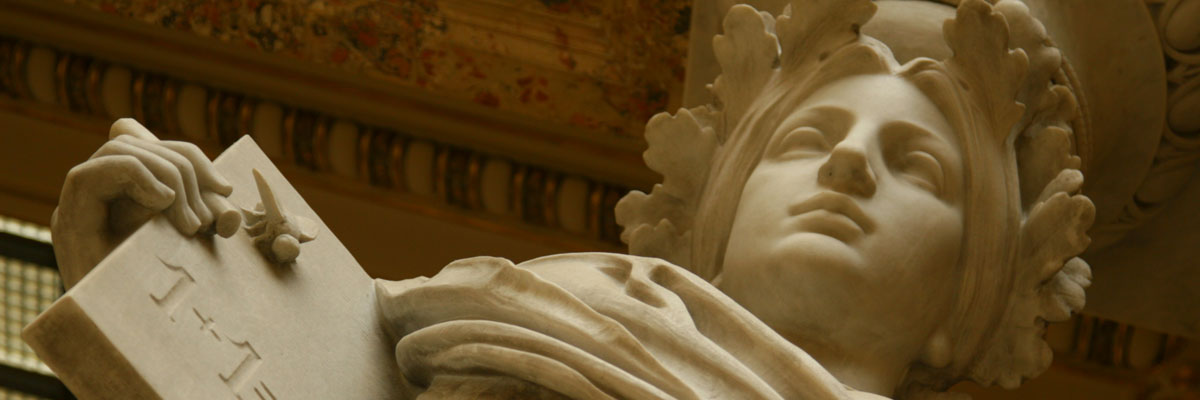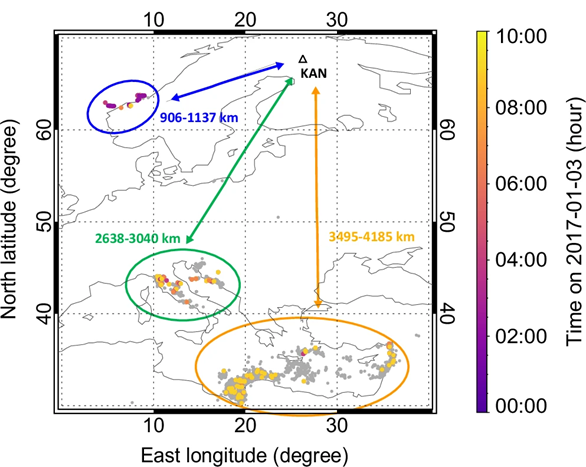
Powerful winter lightning discharges triggered prolonged whistling around the Earth
29. 08. 2024
Seven years ago, the Finnish polar observatory Kannuslehto detected a peculiar type of radio waves at audible frequencies— a series of descending whistling tones that persisted throughout the night until morning. These phenomena occur when radio pulses from lightning travel through the plasma environment in the near-Earth space. However, until now, no one had studied the properties of the lightning discharges that generated these signals. This has been accomplished by two Czech scientists in collaboration with a Finnish colleague, with the results published in the journal Nature Communications.
Electromagnetic signals generated by lightning discharges, known as atmospherics or simply sferics, travel in a waveguide formed by the lower edge of the ionosphere and the Earth's surface, covering distances of up to several thousand kilometres from the source lightning. Some of the electromagnetic energy from these sferics can penetrate through the ionosphere into the Earth’s magnetosphere. As the signal travels through the plasma environment of the magnetosphere, the low-frequency components of the electromagnetic signal travel more slowly than the high-frequency tones.
“If such a signal is captured by a radio receiver on the ground or on a satellite, and we play the recording through a speaker or headphones, we can hear a beautiful whistling tone,” explains Ivana Kolmašová from the Institute of Atmospheric Physics of the Czech Academy of Sciences and the Faculty of Mathematics and Physics at Charles University.
In rare cases, whistling tones (or whistlers) travel within a density tube (also known as a duct) that surrounds a magnetic field line connecting both hemispheres. In such a duct, the signal from the lightning discharge travels between the hemispheres, repeatedly reflecting from the top of the ionosphere, with part of its energy potentially passing back through the ionosphere to the Earth's surface. If a receiving station is located near the orifice of the density tube, the station’s recordings will show a series of whistlers with progressively lower and lower tones.
Three Storms Connected to a Single Duct
On January 3, 2017, a duct appeared near the Finnish polar receiving station Kannuslehto, which is part of the Sodankylä Geophysical Observatory. Shortly after midnight, the station began recording trains of whistlers that continued for nearly eight hours.
“By analysing the station’s recordings along with data from the EUCLID (EUropean Cooperation for LIghtning Detection) and WWLLN (World Wide Lightning Location Network) lightning detection networks, we discovered that the source lightning discharges originated from three different storms, whose electromagnetic traces all shared the same duct,” says Ondřej Santolík from the Institute of Atmospheric Physics of the CAS and the Faculty of Mathematics and Physics at CUNI. “The whistler echo trains during the night were caused by two massive storm systems over the Mediterranean. In the early morning, the strongest whistlers were observed, triggered by a small storm on the western coast of Norway, which produced few but very powerful lightning strokes—half of which could trigger whistler echo trains,” as the scientist explains.
“What surprised us was that the sferics, which travelled from their source lightning on the African coast of the Mediterranean, still had enough energy, after travelling more than 4,000 kilometres beneath the ionosphere, to generate whistler echo trains. We also found that nearly half of the source lightning discharges was positive, which is twice the typical proportion of positive discharges compared to usual European winter storms,” adds Ivana Kolmašová.
Perfectly Bad Weather
The presence of whistler echo trains is clear evidence of the existence of density ducts, about which little is still known. The first reports of whistler echo trains date back to the 1930s, and they occasionally appear in scientific publications in relation to density ducts. However, until now, no one has thoroughly investigated the source lightning discharges of these whistler echo trains.
“Our observations would not have been possible without the perfectly bad weather conditions. In January 2017, the Mediterranean was colder than usual, while northern Europe was warmer. These two anomalies allowed the formation of massive storm clouds in both southern and northern Europe, which then supplied the duct with electromagnetic signals, with its orifice near the polar station that recorded the whistler echo trains,” comments Ondřej Santolík.
“Our analysis suggests that it is crucial to study winter storms and focus on lightning discharges occurring at higher latitudes, as they are capable of generating whistler echo trains and are therefore ideal tools for researching density ducts,” concludes Ivana Kolmašová.
Contact:
prof. RNDr. Ondřej Santolík, Dr.
Department of Space Physics
Institute of Atmospheric Physics of the Czech Academy of Sciences
and Faculty of Mathematics and Physics at Charles University
os@ufa.cas.cz
Ing. Ivana Kolmašová, Ph.D.
Department of Space Physics
Institute of Atmospheric Physics of the Czech Academy of Sciences
and Faculty of Mathematics and Physics at Charles University
iko@ufa.cas.cz
The measurement results were published in Nature Communications in the article titled “Whistler Echo Trains Triggered by Energetic Winter Lightning” by authors I. Kolmašová, O. Santolík, and J. Manninen, https://doi.org/10.1038/s41467-024-51684-0.

Three storm systems supplying the whistler duct on January 3, 2017, near the Kannuslehto polar observatory in Finland, marked by a black triangle and the abbreviation “KAN.” The Norwegian storm associated with the Cyclone Axel is circled in blue, the green oval indicates the Mediterranean storm over the Apennine Peninsula and the Adriatic Sea, and the large storm in the eastern Mediterranean and along the African coast is marked in yellow.
Download the press release here.
Read also
- Matyáš Fendrych Receives ISTA Alumni Award
- Hidden parasites could threaten the health of endangered mountain gorillas
- 90% of mycorrhizal fungal biodiversity hotspots lie outside protected areas
- How lakes connect to groundwater critical for resilience to climate change
- A unique method of rare-earth recycling can strengthen the material independence
- High-energy cosmic rays dominated by heavy METALS
- Genome Tool Developed at CAS Featured in PLoS Genetics
- Why do brain cancer cells steal mitochondria?
- Secrets of the Nano- World: a new comic book about nanotechnology
- Teen duo from Slovakia and Czechia named Global Winner for clean water solution
The Czech Academy of Sciences (the CAS)
The mission of the CAS
The primary mission of the CAS is to conduct research in a broad spectrum of natural, technical and social sciences as well as humanities. This research aims to advance progress of scientific knowledge at the international level, considering, however, the specific needs of the Czech society and the national culture.
President of the CAS
Prof. Eva Zažímalová has started her second term of office in May 2021. She is a respected scientist, and a Professor of Plant Anatomy and Physiology.
She is also a part of GCSA of the EU.